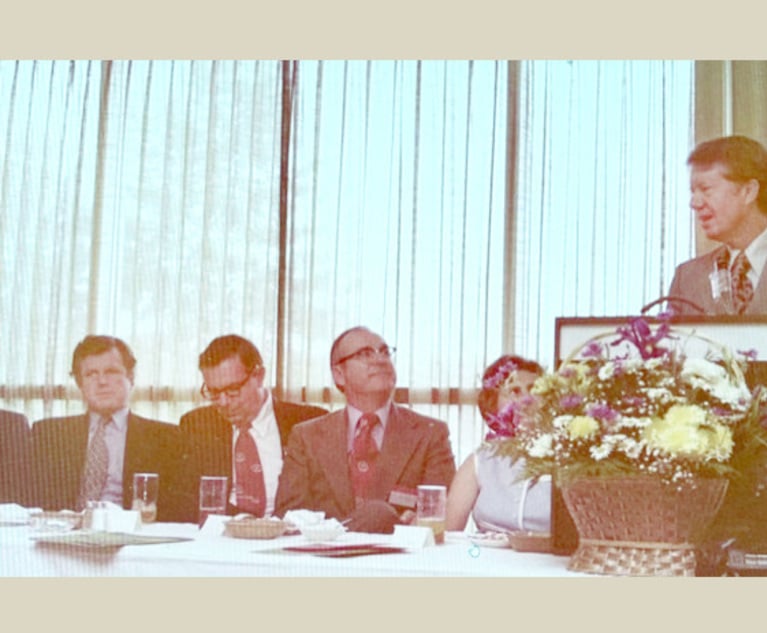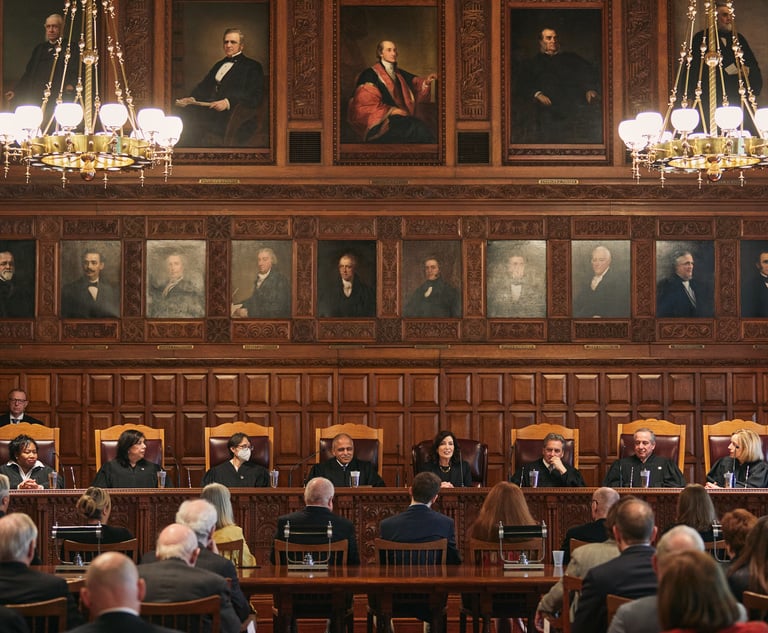Youth Should Be Better Off When They Leave Juvenile Justice System
I believe this interdisciplinary, data-driven decision-making approach has the best chance of improving outcomes for youth.
December 03, 2018 at 11:04 AM
4 minute read
 Chief Judge Janet DiFiore's excellence initiative is not only a new way of doing business for the courts, but it's also a new way of thinking. And a just-launched effort to adopt “results-based accountability” is a microcosm of that system-wide mindset.
Chief Judge Janet DiFiore's excellence initiative is not only a new way of doing business for the courts, but it's also a new way of thinking. And a just-launched effort to adopt “results-based accountability” is a microcosm of that system-wide mindset.
Let me set the backdrop.
Several years ago, the court system joined the Partnership for Youth Justice, a multi-agency, multi-branch collaboration for ongoing juvenile justice reform. The partnership is co-chaired by Frank Woods, chief management analyst for the Unified Court System, Mark White, the deputy commissioner of the Division of Criminal Justice Services (DCJS), and Nina Aledort, associate commissioner with the Office of Children and Family Services (OCFS).
The court system, DCJS, OCFS, the State Education Department and the Office of Mental Health work together to pursue a number of juvenile justice goals centered around a centralized vision, which includes the right intervention at the right time, at the right intensity to the right youth. We believe confinement should be a last resort, and when necessary, the least restrictive setting is preferred. The overarching goals are to at least maintain and hopefully improve public safety while ensuring that youth who enter the juvenile justice system leave it in better shape than they came in. These goals span the continuum of the juvenile justice system from prevention through re-entry, with an ever-present lens of addressing racial and ethnic disparities.
Those are all very worthwhile and noble goals. But in the accountability-centric excellence initiative paradigm, we have to not only come up with and implement great ideas but examine what we do, how well we do it and whether anyone is really better off for our efforts. That is where “results-based accountability” (or RBA) dovetails with the excellence initiative and the Partnership for Youth Justice reform goals.
RBA was developed by Mark Friedman, author of a book titled, “Trying Hard is Not Good Enough.” The title alone—“trying hard is not good enough”—sums up the excellence initiative philosophy that all of us at the Office of Court Administration are under orders to encourage and implement and it is consistent with the vision and goals of the Partnership for Youth Justice. This summer, the Partnership for Youth Justice supported the use of RBA as a tool to determine the actual impact of juvenile justice reforms locally, regionally and statewide.
Over a period of four months, we held RBA regional training in Western New York, Central New York, the Finger Lakes, the Mohawk Valley, the Capital Region, the North Country, the mid-Hudson and in Long Island. Nearly 200 interdisciplinary stakeholders—judges, court personnel, law enforcement, social service providers, attorneys and others—from 47 counties embraced a data-driven process for achieving continuous quality improvement in juvenile justice. Crucially, this is a results-oriented framework that begins with the end goal and then works backward toward the means to the desired outcome.
For instance, one general goal of the partnership is to use detention only for youth at high-risk of committing a crime or failing to appear in court. From there, we sequentially ask several questions: What is the specific outcome desired? What are the means toward that goal? Who are the stakeholders? Where are the gaps that may prevent us from reaching our objective? How are we doing, and how can we plot our progress or lack thereof graphically? And when all that is done, we take an objective look at the big picture and start again. Under the excellence initiative credo, there's no resting on our laurels.
As a result of the regional training, dozens of local and regional stakeholders, including judges, are now thinking in those terms and have a unifying vision for juvenile justice reform efforts at the local, regional and state level. I believe this interdisciplinary, data-driven decision-making approach has the best chance of improving outcomes for youth.
Edwina G. Mendelson is deputy chief administrative judge for justice initiatives.
This content has been archived. It is available through our partners, LexisNexis® and Bloomberg Law.
To view this content, please continue to their sites.
Not a Lexis Subscriber?
Subscribe Now
Not a Bloomberg Law Subscriber?
Subscribe Now
NOT FOR REPRINT
© 2025 ALM Global, LLC, All Rights Reserved. Request academic re-use from www.copyright.com. All other uses, submit a request to [email protected]. For more information visit Asset & Logo Licensing.
You Might Like
View All
Jimmy Carter’s 1974 Law Day Speech: A Call for Lawyers to Do the Public Good
14 minute read
For Safer Traffic Stops, Replace Paper Documents With ‘Contactless’ Tech
4 minute readTrending Stories
Who Got The Work
Michael G. Bongiorno, Andrew Scott Dulberg and Elizabeth E. Driscoll from Wilmer Cutler Pickering Hale and Dorr have stepped in to represent Symbotic Inc., an A.I.-enabled technology platform that focuses on increasing supply chain efficiency, and other defendants in a pending shareholder derivative lawsuit. The case, filed Oct. 2 in Massachusetts District Court by the Brown Law Firm on behalf of Stephen Austen, accuses certain officers and directors of misleading investors in regard to Symbotic's potential for margin growth by failing to disclose that the company was not equipped to timely deploy its systems or manage expenses through project delays. The case, assigned to U.S. District Judge Nathaniel M. Gorton, is 1:24-cv-12522, Austen v. Cohen et al.
Who Got The Work
Edmund Polubinski and Marie Killmond of Davis Polk & Wardwell have entered appearances for data platform software development company MongoDB and other defendants in a pending shareholder derivative lawsuit. The action, filed Oct. 7 in New York Southern District Court by the Brown Law Firm, accuses the company's directors and/or officers of falsely expressing confidence in the company’s restructuring of its sales incentive plan and downplaying the severity of decreases in its upfront commitments. The case is 1:24-cv-07594, Roy v. Ittycheria et al.
Who Got The Work
Amy O. Bruchs and Kurt F. Ellison of Michael Best & Friedrich have entered appearances for Epic Systems Corp. in a pending employment discrimination lawsuit. The suit was filed Sept. 7 in Wisconsin Western District Court by Levine Eisberner LLC and Siri & Glimstad on behalf of a project manager who claims that he was wrongfully terminated after applying for a religious exemption to the defendant's COVID-19 vaccine mandate. The case, assigned to U.S. Magistrate Judge Anita Marie Boor, is 3:24-cv-00630, Secker, Nathan v. Epic Systems Corporation.
Who Got The Work
David X. Sullivan, Thomas J. Finn and Gregory A. Hall from McCarter & English have entered appearances for Sunrun Installation Services in a pending civil rights lawsuit. The complaint was filed Sept. 4 in Connecticut District Court by attorney Robert M. Berke on behalf of former employee George Edward Steins, who was arrested and charged with employing an unregistered home improvement salesperson. The complaint alleges that had Sunrun informed the Connecticut Department of Consumer Protection that the plaintiff's employment had ended in 2017 and that he no longer held Sunrun's home improvement contractor license, he would not have been hit with charges, which were dismissed in May 2024. The case, assigned to U.S. District Judge Jeffrey A. Meyer, is 3:24-cv-01423, Steins v. Sunrun, Inc. et al.
Who Got The Work
Greenberg Traurig shareholder Joshua L. Raskin has entered an appearance for boohoo.com UK Ltd. in a pending patent infringement lawsuit. The suit, filed Sept. 3 in Texas Eastern District Court by Rozier Hardt McDonough on behalf of Alto Dynamics, asserts five patents related to an online shopping platform. The case, assigned to U.S. District Judge Rodney Gilstrap, is 2:24-cv-00719, Alto Dynamics, LLC v. boohoo.com UK Limited.
Featured Firms
Law Offices of Gary Martin Hays & Associates, P.C.
(470) 294-1674
Law Offices of Mark E. Salomone
(857) 444-6468
Smith & Hassler
(713) 739-1250








